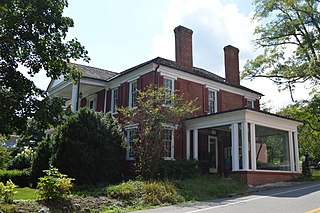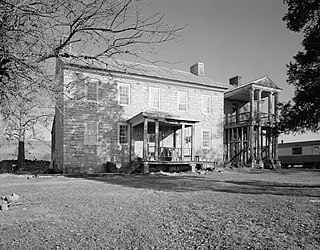
The Greenbrier is a luxury resort located in the Allegheny Mountains near White Sulphur Springs in Greenbrier County, West Virginia, in the United States.

This is a list of properties and historic districts in West Virginia that are listed on the National Register of Historic Places. There are listings in every one of West Virginia's 55 counties.

The Pearl S. Buck Birthplace is a historic home in Hillsboro, West Virginia where American writer Pearl S. Buck was born. The home now serves as a museum offering guided tours. The site also includes a carpentry shop and barn with over 100 historic farm and woodworking tools, and the log home of Buck's father's family, the Sydenstrickers, which was moved from Greenbrier County.
Homeplace, also known as Homestead Farm, is a historic home located near Frankford, Greenbrier County, West Virginia. It was built about 1850, and is a two-story, brick Federal style dwelling with a hipped roof. It has a symmetrical facade and sits on a stone foundation.
Alexander W. Arbuckle I House, also known as the Michael Baker House, is a historic home located near Lewisburg, Greenbrier County, West Virginia. It was built in 1822, and is a two-story, brick "T"-shaped residence with Greek Revival style influences. It features a two-story portico with four plastered round columns and Chinese Chippendale style railings.
David S. Creigh House, also known as the "Montescena" and Boone Farm, is a historic home located near Lewisburg, Greenbrier County, West Virginia. Although the house has "outstanding architectural features", it is most known for being the site of the 1863 death of a Union soldier which led to the execution of David S. Creigh, the owner, in 1864.
Hartland, also known as the Rodgers Farm, is a historic home located near Lewisburg, Greenbrier County, West Virginia. The original section was built about 1800, with the two story log addition built sometime after 1812. A third section of similar size to the second was added before 1860. About 1895, a fourth addition was built. In 1912, a porch was added.
Morlunda, also known as the Col. Samuel McClung Place and Oscar Nelson Farm, is a historic home located near Lewisburg, Greenbrier County, West Virginia. It was built in 1827–1828, and consists of a main house with ell. The main house is a two-story brick building measuring 56 feet long and 21 feet deep. The ell measures 48 feet and it connects to a 1+1⁄2-story formerly detached kitchen.

The John A. North House is a historic house museum and archives located in Lewisburg, Greenbrier County, West Virginia. Currently, the North House is Greenbrier County's only historic house museum. Since 1976, The Greenbrier Historical Society has operated within the North House, and in 1992 the North House was officially purchased by the Greenbrier Historical Society. In 1992, the home officially became known as "North House Museum, Greenbrier Historical Society."

Renick Farm, also known as the William Renick Farm, is an historic home located near Renick, Greenbrier County, West Virginia. The farmhouse was built between 1787 and 1792, and is a two-story, limestone dwelling with a gable roof in the Georgian style. A brick Federal style addition was built in 1825, and it features a two-story, temple form entrance portico with Doric order columns and Chinese Chippendale railings. Also on the property are a contributing barn (1901) and smoke house.
Mountain Home, also known as Locust Hill and Robert Dickson House, is a historic home located near White Sulphur Springs, Greenbrier County, West Virginia. It was built about 1833, and is a large, two-story brick dwelling with a kitchen ell. It features a two-story, one-bay lunette-adorned pediment with plastered brick Doric order paired columns. It has Late Federal and Roman Revival elements on both the exterior and interior.
Meadow River Lumber Building is a historic building located on the grounds of the State Fair of West Virginia at Fairlea, Greenbrier County, West Virginia. It was built in 1928, to showcase the products of the Meadow River Lumber Company (MERILUCO). It is a one-story, Bungalow-style frame building with a small center front gable rising from the roofline. The front facade features a full length front porch.

Greenbrier County Courthouse is a historic courthouse building located at Lewisburg, Greenbrier County, West Virginia. In 1973 the courthouse and the adjacent spring house, the Lewis Spring, were listed on the National Register of Historic Places. and are a historic and
Tuckwiller Tavern, also known as Valley View Stock Farm, Inc. and Wilson Farm, is a historic tavern located at Lewisburg, Greenbrier County, West Virginia. It was built between 1826 and 1828, and is a large, two-story rectangular brick building with a one-story ell in an early rusticated Greek Revival style. It sits on a fieldstone foundation and features a portico supported by four massive, white wooden columns. Also on the property is a brick smokehouse. During the American Civil War, it was used as a headquarters and barracks in 1864 by Union General David Hunter.

Deitz Farm, also known as General Robert E. Lee Headquarters, is a national historic district located near Meadow Bluff, Greenbrier County, West Virginia. The house was built about 1840, and is a two-story side gabled red brick residence in the Greek Revival style. It features a three bay, one-story wooden porch across the front of the house. Also on the property are two contributing wooden outbuildings and earthworks associated with the property's role as General Robert E. Lee Headquarters during the American Civil War.

Byrnside-Beirne-Johnson House, also known as "Willowbrook," is a historic home located near Union, Monroe County, West Virginia. The house began as a pioneer log fort built by six families in 1770. After 1855, it was enlarged to a large 2½-story, five-bay, "T"-shaped dwelling with a two-story rear wing. It is covered with board-and-batten siding in the Gothic Revival style. The front features a two-story gable end porch built about 1900. Also on the property is a contributing smokehouse.

David Stewart Farm, also known as Rock Valley Farm, is a historic house and farm located near Triadelphia, Ohio County, West Virginia. The main house was built about 1812, and is a two-story sandstone dwelling. It is a rectangular, single pile, center-hall structure. Also on the property are a sandstone spring house with workshop above, corncrib, washhouse, and old barn.

Marlinton Chesapeake and Ohio Railroad Station was a historic railway station and bunkhouse located at Marlinton, Pocahontas County, West Virginia. They were built in 1901 by the Chesapeake and Ohio Railroad. The station was a frame, rectangular, one-story building measuring 76 feet by 16 feet and used for both passengers and freight. The bunkhouse is a one-story frame building measuring 24 feet by 16 feet. Both buildings featured vertical board and batten siding and decorative brackets in the wide projecting eaves of their gable roofs. Passenger service ended at Marlinton in 1958. Given its location at the trailhead of the Greenbrier River Trail, the station was renovated to house the Pocahontas County Convention and Visitors Bureau. The station was destroyed by fire in 2008; the bunkhouse remains extant.
John W. Dunn was an architect and master builder in West Virginia.

Edgefield is a historic home and farm complex located at Renick, Greenbrier County, West Virginia. The Edgefield House is a frame, two-story, three-bay building with a side gable roof. It has a two-story ell with an asymmetrical gabled roof. The front facade is dominated by a full-height (two-story) open porch supported by four large square columns. Also on the property are the contributing coal shed, meat house, cistern, granary, machine shed, and two barns. Between 1935 and 1960, Floy Whiting Whorrell, a widow operated the farm.













